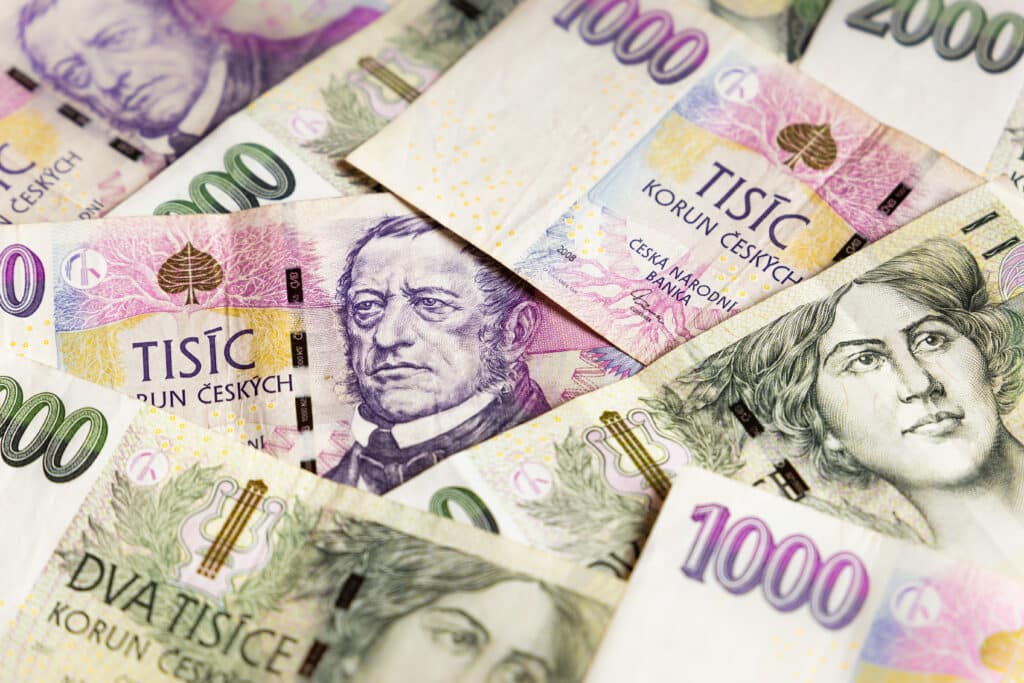The official currency of the Czech Republic is the “Czech koruna,” or the “koruna česká.” In English, it is called the “Czech crown.” The official currency of the Czech Republic since 1993, it is issued by the Czech Central Bank (CNB) and its ISO currency code is “CZK.” The local acronym is “Kč,” which is commonly written after the numeric value (e.g., 100 Kč), but you can also write “CZK” after the numeric value (e.g., 100 CZK).

Czech Banknotes and Coins
Although most establishments in the Czech Republic accept credit cards, many travelers and residents like to have some Czech koruna available in cash.
Czech coins come in the following denominations:
- 1, 2, 5, 10, 20, and 50 CZK
It’s not difficult to tell the coins apart, even if you are seeing them for the first time. The bigger the coin, the higher the value.
Czech banknotes come in the following denominations:
- 100; 200; 500; 1,000; 2,000; and 5,000 CZK
CZK Exchange Rate
- To see the current Czech koruna-to-dollar exchange rate, check out today’s rate with Remitly.
Interesting Things About the Czech Koruna
Here are some fun and informative things about the Czech koruna that you might find interesting.
1. The Czech koruna was introduced in 1993.
The Czech koruna was introduced as the country’s currency in 1993, just after the dissolution of Czechoslovakia and the creation of the Czech Republic. The first Czech banknotes, with values of 20; 50; 100; 500; and 1,000 koruna, were Czechoslovakian notes with adhesive stamps added to them.
2. The Czech Republic did not adopt the euro.
The Czech Republic officially became a member state of the European Union (EU) on May 1, 2004. It did not, however, adopt the euro as its currency, choosing to maintain economic independence rather than become part of the eurozone. That makes it one of eight countries in the EU that use their own currency.

3. The 100- and 200-koruna bills got security upgrades in 2018.
The 100- and 200-koruna bills kept the same appearance but went through an upgrade in security features in 2018 to protect against counterfeiting. The new security features include a narrow strip that turns from orange to green when you tilt it. The notes are also marked with an anti-copy pattern that disables the scanning function on digital imaging devices, including photocopiers.
4. The designs of the Czech koruna are works of art.
Famed Czech artist Oldřich Kulhánek was commissioned to design the most recent Czech koruna banknotes. One side of each note features a notable historic figure, and the other side features symbols and collages. Every time you hold a Czech koruna, you carry a work of art.
5. Small-denomination coins have been taken out of circulation.
Each koruna can be subdivided into 100 haléřů. When the Czech koruna came into existence in 1993, the available denominations included 10-, 20-, and 50-haléřů coins. However, the 10- and 20-haléřů coins went out of circulation in October 2003, and the 50-haléřů coins followed in August 2008. The CNB removed them because of their diminishing purchasing power and use. But since stores and other institutions still price items to the 1-haléř level, they round the total to the nearest koruna when processing transactions.

More About the Czech Republic
The Czech Republic is a country in Central Europe bordered by Poland to its north, Germany to its west, Austria to its south, and Slovakia to its East. It is known for its beautiful cities, well-preserved castles, and friendly people.
The capital of the Czech Republic, Prague, is famous for its stunning Renaissance, Gothic, and Baroque buildings. It is consistently one of the most visited cities globally and has earned such nicknames as the “Mother of Cities,” the “Heart of Europe,” and the “City of 100 Towers.”
The Czech Republic is becoming a favorite destination among digital nomads. It is one of the increasing number of countries to issue a digital nomad visa. The visa allows foreign nationals to live and work in the country for a year, compared to the standard maximum stay of 90 days in Europe.
Sending Money to the Czech Republic
You can send money to the Czech Republic with Remitly. New customers may be eligible for a special offer on their first transfer.
Further Reading
If you enjoyed learning about the Czech koruna, the following articles may be of interest to you: